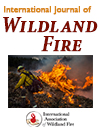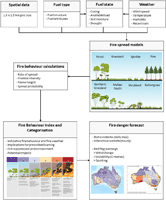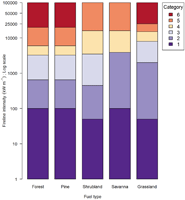International Journal of Wildland Fire
Volume 33
Number 3 2024
This study explores drivers of international resources sent to aid with US fire management, focusing on ground and overhead personnel. Using 2008–2020 data, this study investigates conditions for international sharing and potential barriers. Findings show sharing is more likely with higher preparedness, larger areas burned, and greater impact on people and structures.
Fires are commonly patchy and of varying severity. Effects of fire severity and burn patchiness are rarely incorporated into fuel models. We show that accounting for fire patchiness and fire severity improves predictions of fire behaviour. This is important for operational fire management and fire risk assessments.
A spatial simulation model for predicting wildland surface fire behaviour is described. The model is tested under idealised environmental conditions and validated with real-world case studies in Sardinia, Italy. Results are promising in terms of model performance, suggesting its potential to provide a valuable contribution in operational fire management applications.
This article belongs to the Collection ICFFR.
We introduce the Australian Fire Danger Rating System (AFDRS), providing a history of fire danger rating in Australia and requirement for advancements. We describe development, design principles and the supporting framework of the AFDRS as an introduction to subsequent papers in this series.
This article belongs to the Collection Australian Fire Danger Rating System.
We identify and present defined categories and thresholds for the Australian Fire Danger Rating System: Research Prototype based on reflecting transitions in fire behaviour that result in application of different fire management strategies or associated with variation in potential for serious consequences and impacts.
This article belongs to the Collection Australian Fire Danger Rating System.
We present a 19-year climatology of the Australian Fire Danger Rating System: Research Prototype (AFDRSRP), recently implemented operationally throughout Australia. The climatology describes the typical spatial and temporal behaviour of the AFDRSRP. It is important for users to improve familiarity with the new system, and to ensure it performs as expected.
This article belongs to the Collection Australian Fire Danger Rating System.
We describe an online mapping tool, SoCal EcoServe (https://manzanita.forestry.oregonstate.edu/EcoServeHome/) to estimate wildfire impacts on ecosystem services in shrub-dominated southern California. We describe the methodology and results using the Alisal Fire. The tool is designed to support post-fire damage assessments and restoration decision-making by resource managers.
This article belongs to the Collection Fire and Climate.
In the process of firefighters escaping from wildfires, the planned escape route should not only consider the shortest travel time, but also the safety of the route. This article establishes an escape route model that ensures both the rapid evacuation of firefighters and their safety throughout the entire escape process.
Scanning remote sensing instruments allow us to understand the processes contributing to extreme wildfire fire plume behaviours including the development of strong rotation in the smoke column and fire-generated clouds reaching deep into the atmosphere. These data help us understand which fires are prone to extreme fire behaviour.







